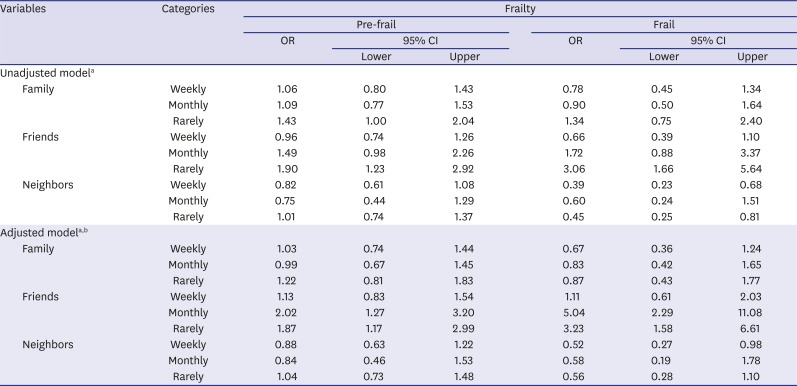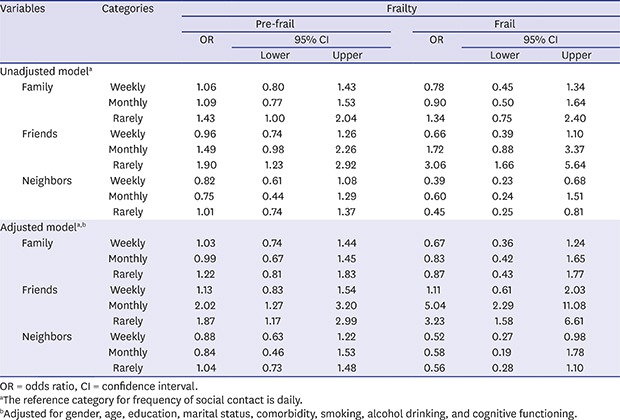2. Fried LP, Tangen CM, Walston J, Newman AB, Hirsch C, Gottdiener J, et al. Frailty in older adults: evidence for a phenotype. J Gerontol A Biol Sci Med Sci. 2001; 56(3):M146–M156. PMID:
11253156.

3. Rockwood K, Stadnyk K, MacKnight C, McDowell I, Hébert R, Hogan DB. A brief clinical instrument to classify frailty in elderly people. Lancet. 1999; 353(9148):205–206. PMID:
9923878.

4. Tarazona-Santabalbina FJ, Gómez-Cabrera MC, Pérez-Ros P, Martínez-Arnau FM, Cabo H, Tsaparas K, et al. A multicomponent exercise intervention that reverses frailty and improves cognition, emotion, and social networking in the community-dwelling frail elderly: a randomized clinical trial. J Am Med Dir Assoc. 2016; 17(5):426–433. PMID:
26947059.
5. Ng TP, Feng L, Nyunt MS, Feng L, Niti M, Tan BY, et al. Nutritional, physical, cognitive, and combination interventions and frailty reversal among older adults: a randomized controlled trial. Am J Med. 2015; 128(11):1225–1236.e1. PMID:
26159634.

6. Woo J, Goggins W, Sham A, Ho SC. Social determinants of frailty. Gerontology. 2005; 51(6):402–408. PMID:
16299422.

7. Berkman LF, Glass T, Brissette I, Seeman TE. From social integration to health: Durkheim in the new millennium. Soc Sci Med. 2000; 51(6):843–857. PMID:
10972429.

8. Roh HW, Lee Y, Lee KS, Chang KJ, Kim J, Lee SJ, et al. Frequency of contact with non-cohabitating adult children and risk of depression in elderly: a community-based three-year longitudinal study in Korea. Arch Gerontol Geriatr. 2015; 60(1):183–189. PMID:
25442783.

9. Teo AR, Choi H, Andrea SB, Valenstein M, Newsom JT, Dobscha SK, et al. Does mode of contact with different types of social relationships predict depression in older adults? Evidence from a nationally representative survey. J Am Geriatr Soc. 2015; 63(10):2014–2022. PMID:
26437566.

10. Obisesan TO, Gillum RF. Cognitive function, social integration and mortality in a U.S. national cohort study of older adults. BMC Geriatr. 2009; 9(1):33. PMID:
19638207.

11. Kim JH, Lee SG, Kim TH, Choi Y, Lee Y, Park EC. Influence of Social Engagement on Mortality in Korea: analysis of the Korean Longitudinal Study of Aging (2006–2012). J Korean Med Sci. 2016; 31(7):1020–1026. PMID:
27365997.

12. Fratiglioni L, Paillard-Borg S, Winblad B. An active and socially integrated lifestyle in late life might protect against dementia. Lancet Neurol. 2004; 3(6):343–353. PMID:
15157849.

13. Etman A, Kamphuis CB, van der Cammen TJ, Burdorf A, van Lenthe FJ. Do lifestyle, health and social participation mediate educational inequalities in frailty worsening? Eur J Public Health. 2015; 25(2):345–350. PMID:
25061232.

14. Gale CR, Syddall HE, Cooper C, Sayer AA, Bergman H, Brunner EJ. Close relationships and risk of frailty: the Hertfordshire Cohort Study. J Am Geriatr Soc. 2012; 60(2):390–392. PMID:
22332694.

15. Fratiglioni L, Wang HX, Ericsson K, Maytan M, Winblad B. Influence of social network on occurrence of dementia: a community-based longitudinal study. Lancet. 2000; 355(9212):1315–1319. PMID:
10776744.

16. Lee SH, Kim YB. Which type of social activities may reduce cognitive decline in the elderly?: a longitudinal population-based study. BMC Geriatr. 2016; 16(1):165. PMID:
27677321.

17. Kim J, Lee Y, Won CW, Lee KE, Chon D. Nutritional status and frailty in community-dwelling older Korean adults: the Korean Frailty and Aging Cohort Study. J Nutr Health Aging. 2018; 22(7):774–778. PMID:
30080218.

18. Kang YW. A normative study of the Korean-Mini Mental State Examination (K-MMSE) in the elderly. Korean J Psychol. 2006; 25(2):1–12.
19. Cramm JM, Nieboer AP. Relationships between frailty, neighborhood security, social cohesion and sense of belonging among community-dwelling older people. Geriatr Gerontol Int. 2013; 13(3):759–763. PMID:
23190426.

20. Lee SH, Kim YB. Which type of social activities decrease depression in the elderly? An analysis of a population-based study in South Korea. Iran J Public Health. 2014; 43(7):903–912. PMID:
25909058.
21. James BD, Wilson RS, Barnes LL, Bennett DA. Late-life social activity and cognitive decline in old age. J Int Neuropsychol Soc. 2011; 17(6):998–1005. PMID:
22040898.

22. Smith KP, Christakis NA. Social networks and health. Annu Rev Sociol. 2008; 34(1):405–429.

23. Brummett BH, Barefoot JC, Siegler IC, Clapp-Channing NE, Lytle BL, Bosworth HB, et al. Characteristics of socially isolated patients with coronary artery disease who are at elevated risk for mortality. Psychosom Med. 2001; 63(2):267–272. PMID:
11292274.

24. Frasure-Smith N, Lespérance F, Gravel G, Masson A, Juneau M, Talajic M, et al. Social support, depression, and mortality during the first year after myocardial infarction. Circulation. 2000; 101(16):1919–1924. PMID:
10779457.

25. Kaplan GA, Salonen JT, Cohen RD, Brand RJ, Syme SL, Puska P. Social connections and mortality from all causes and from cardiovascular disease: prospective evidence from eastern Finland. Am J Epidemiol. 1988; 128(2):370–380. PMID:
3394703.

26. Okamoto K, Tanaka Y. Subjective usefulness and 6-year mortality risks among elderly persons in Japan. J Gerontol B Psychol Sci Soc Sci. 2004; 59(5):246–249.








 PDF
PDF Citation
Citation Print
Print




 XML Download
XML Download